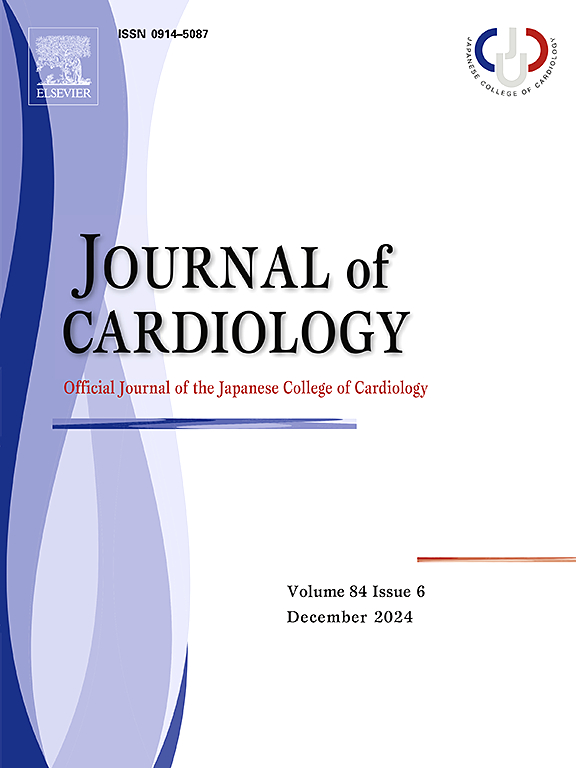Relationship between left atrial/left ventricular diameter ratio and outcomes in patients with hypertrophic cardiomyopathy
IF 2.5
3区 医学
Q2 CARDIAC & CARDIOVASCULAR SYSTEMS
引用次数: 0
Abstract
Background
Although diastolic dysfunction is the main pathophysiological feature of hypertrophic cardiomyopathy (HCM), it remains to be clarified whether parameters of diastolic function can reliably determine HCM prognosis. In patients with reduced left ventricular (LV) distensibility, chronic elevation of LV diastolic pressure is seen with a smaller than expected LV size. Accordingly, patients with HCM with severe LV diastolic dysfunction typically demonstrate left atrial (LA) dilation and a disproportionately smaller left ventricle. Therefore, we investigated the relationship between LA/LV diameter ratio, as a potential indicator of disease progression, and outcomes in patients with HCM.
Methods
We included 468 patients in whom LA and LV end-diastolic diameter were successfully evaluated by echocardiography at the initial assessment. We divided the patients into two groups: those with an LA/LV diameter ratio > 1 and those with an LA/LV diameter ratio ≤ 1. We compared the HCM-related death rates between the two groups.
Results
Of the 468 patients, 96 patients (20.5 %) with HCM showed an LA/LV diameter ratio > 1. In the univariate analysis, patients with an LA/LV diameter ratio > 1 had a significantly greater likelihood of HCM-related death than patients with an LA/LV diameter ratio ≤ 1 (log-rank p = 0.002). In the multivariate Cox proportional hazards analysis, when including LA/LV diameter ratio > 1 and imbalanced baseline variables, an LA/LV diameter ratio > 1 was an independent determinant of HCM-related death (adjusted hazard ratio: 1.87, 95 % confidence interval: 1.08–3.24; p = 0.024).
Conclusion
LA/LV diameter ratio can be easily evaluated and may be useful for risk stratification of HCM-related death in patients with HCM.

肥厚型心肌病患者左心房/左心室直径比与预后之间的关系
尽管舒张功能障碍是肥厚型心肌病(HCM)的主要病理生理特征,但舒张功能参数是否能可靠地判断 HCM 的预后仍有待明确。在左心室(LV)扩张性降低的患者中,左心室舒张压长期升高,左心室尺寸小于预期。因此,左心室舒张功能严重障碍的 HCM 患者通常表现为左心房(LA)扩张和左心室不成比例地变小。因此,我们研究了作为疾病进展潜在指标的 LA/LV 直径比与 HCM 患者预后之间的关系。我们纳入了 468 例在初次评估时通过超声心动图成功评估了 LA 和左心室舒张末期直径的患者。我们将患者分为两组:LA/LV 直径比大于 1 的患者和 LA/LV 直径比小于 1 的患者。我们比较了两组患者与 HCM 相关的死亡率。在 468 例患者中,96 例(20.5%)HCM 患者的 LA/LV 直径比大于 1。在单变量分析中,LA/LV 直径比 > 1 的患者发生 HCM 相关死亡的可能性明显高于 LA/LV 直径比 ≤ 1 的患者(log-rank = 0.002)。在多变量 Cox 比例危险分析中,当包括 LA/LV 直径比 > 1 和不平衡基线变量时,LA/LV 直径比 > 1 是 HCM 相关死亡的独立决定因素(调整后危险比:1.87,95 % 置信区间:1.08-3.24;= 0.024)。LA/LV 直径比易于评估,可能有助于对 HCM 患者与 HCM 相关的死亡进行风险分层。
本文章由计算机程序翻译,如有差异,请以英文原文为准。
求助全文
约1分钟内获得全文
求助全文
来源期刊

Journal of cardiology
CARDIAC & CARDIOVASCULAR SYSTEMS-
CiteScore
4.90
自引率
8.00%
发文量
202
审稿时长
29 days
期刊介绍:
The official journal of the Japanese College of Cardiology is an international, English language, peer-reviewed journal publishing the latest findings in cardiovascular medicine. Journal of Cardiology (JC) aims to publish the highest-quality material covering original basic and clinical research on all aspects of cardiovascular disease. Topics covered include ischemic heart disease, cardiomyopathy, valvular heart disease, vascular disease, hypertension, arrhythmia, congenital heart disease, pharmacological and non-pharmacological treatment, new diagnostic techniques, and cardiovascular imaging. JC also publishes a selection of review articles, clinical trials, short communications, and important messages and letters to the editor.
 求助内容:
求助内容: 应助结果提醒方式:
应助结果提醒方式:


